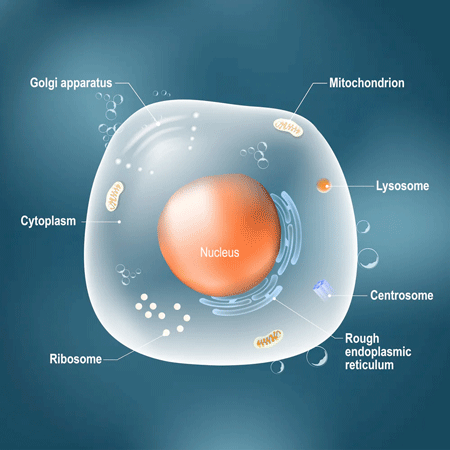Messenger RNA (mRNA): The Cellular Messenger Delivering Genetic Instructions
What is Messenger RNA (mRNA)?
Messenger RNA (mRNA) is a type of single-stranded ribonucleic acid (RNA) molecule that plays a crucial role in the process of protein synthesis. mRNA acts as an intermediary between the genetic information stored in DNA and the protein-making machinery of the cell, called ribosomes. It carries the genetic blueprint copied from DNA and delivers it to ribosomes, where it serves as a template for the synthesis of specific proteins.

The Role of mRNA in Gene Expression
Messenger RNA is an essential component of the gene expression process, which involves the conversion of genetic information into functional proteins. The journey of mRNA begins in the cell nucleus, where it is synthesized through a process called transcription:
- Transcription: During transcription, the enzyme RNA polymerase reads the DNA sequence of a gene and uses it as a template to synthesize a complementary strand of pre-mRNA. This pre-mRNA undergoes further processing, including splicing, to remove non-coding regions (introns) and join together the coding regions (exons), resulting in mature mRNA.
- mRNA Export: Once the mature mRNA is formed, it is transported out of the nucleus and into the cytoplasm, where it can interact with ribosomes.
- Translation: At the ribosome, the genetic code carried by the mRNA is translated into an amino acid sequence. The ribosome reads the mRNA in a three-nucleotide code called a codon, with each codon specifying a particular amino acid. As the ribosome moves along the mRNA, it assembles the corresponding amino acids into a growing polypeptide chain, which eventually folds into a functional protein.
Through this process, mRNA serves as the critical link between the genetic information encoded in DNA and the production of proteins that carry out various functions in the cell.
Structure and Stability of mRNA
Messenger RNA molecules have a distinct structure that enables them to perform their function effectively:
- Single-Stranded: Unlike DNA, which is double-stranded, mRNA is a single-stranded molecule. This allows it to be read by ribosomes during translation.
- Nucleotide Composition: mRNA is composed of four types of nucleotides: adenine (A), uracil (U), guanine (G), and cytosine (C). These nucleotides are linked together by phosphodiester bonds to form the mRNA strand.
- 5' Cap and 3' Poly(A) Tail: Mature mRNA molecules have additional modifications at their ends. The 5' end of the mRNA is capped with a modified guanine nucleotide, which protects the mRNA from degradation and facilitates its recognition by ribosomes. The 3' end of the mRNA has a string of adenine nucleotides, known as the poly(A) tail, which also contributes to mRNA stability and translation efficiency.
Despite these structural features, mRNA molecules are relatively unstable compared to DNA. They have a shorter lifespan and are prone to degradation by cellular enzymes called ribonucleases (RNases). The inherent instability of mRNA allows cells to rapidly adjust protein levels in response to changing conditions by controlling the synthesis and degradation of specific mRNA molecules.
mRNA in Biotechnology and Medicine
The understanding of mRNA and its role in gene expression has opened up exciting possibilities in biotechnology and medicine:
mRNA Vaccines
mRNA vaccines have gained significant attention in recent years, particularly in the context of the COVID-19 pandemic. These vaccines deliver mRNA encoding a specific viral antigen into cells, allowing the cells to produce the antigen and elicit an immune response. mRNA vaccines offer several advantages, including rapid development, scalable production, and the ability to induce both humoral and cellular immunity.
Protein Replacement Therapy
mRNA can be used as a therapeutic tool to replace missing or defective proteins in diseases caused by genetic mutations. By delivering mRNA encoding the correct protein sequence into cells, it is possible to restore the production of functional proteins and alleviate disease symptoms. This approach has shown promise in treating genetic disorders such as cystic fibrosis and hemophilia.
Cellular Reprogramming
mRNA can be employed to reprogram cells into different cell types, a process known as cellular reprogramming. By introducing specific mRNA molecules encoding reprogramming factors, researchers can convert adult somatic cells into induced pluripotent stem cells (iPSCs) or directly reprogram them into desired cell types. This technology holds great potential for regenerative medicine and disease modeling.
Challenges and Future Perspectives
While mRNA-based technologies offer immense potential, there are still challenges to overcome. One of the main hurdles is the delivery of mRNA molecules into target cells efficiently and safely. Researchers are developing various delivery systems, such as lipid nanoparticles and viral vectors, to improve mRNA delivery and minimize off-target effects.
Another challenge is the stability of mRNA molecules. Efforts are being made to engineer mRNA with enhanced stability and reduced immunogenicity to improve its therapeutic efficacy and safety profile.
As our understanding of mRNA biology continues to expand, it is expected that mRNA-based approaches will find broader applications in the fields of gene therapy, personalized medicine, and drug discovery. The ability to harness the power of mRNA to modulate gene expression and produce desired proteins holds immense promise for addressing a wide range of medical challenges.
Further Reading
Current Opinion in Systems Biology, States of decay: The systems biology of mRNA stability
Signal Transduction and Targeted Therapy, mRNA-based therapeutics: powerful and versatile tools to combat diseases
Fundamental Research, mRNA therapeutics: New vaccination and beyond
